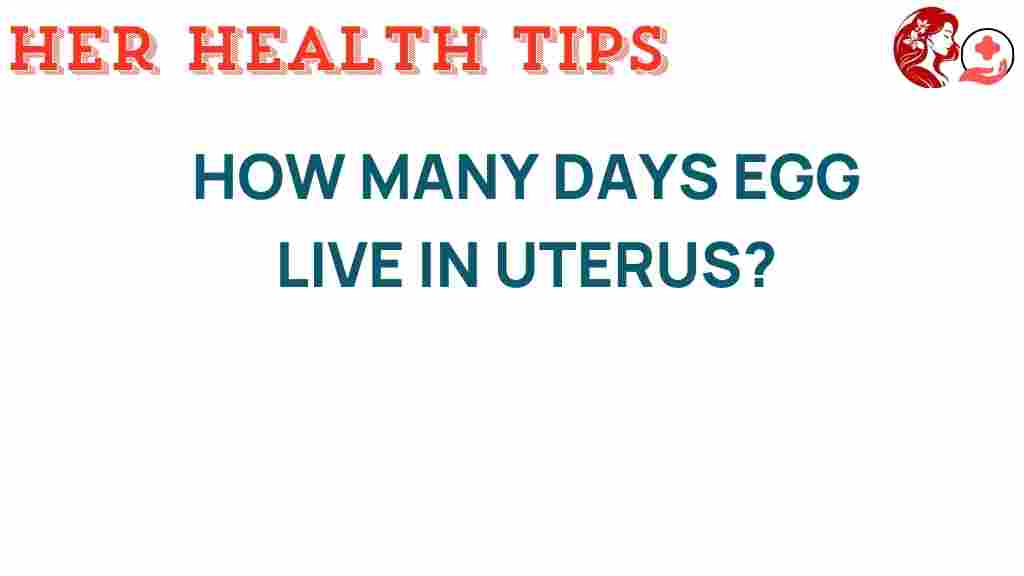The Fascinating Journey: How Long Does an Egg Survive in the Uterus?
Understanding the lifespan of an egg is crucial for anyone interested in fertility and reproductive health. The journey of an egg, from its formation to its potential fertilization and implantation in the uterus, involves many intricate processes that are pivotal to conception and women’s health. In this article, we will explore the lifespan of an egg, the menstrual cycle, ovulation, and the significance of these processes in reproductive health.
What is Egg Lifespan?
The egg lifespan refers to the period during which a woman’s egg is viable and can be fertilized. This lifespan is primarily determined by the ovulation cycle, which is a key component of the menstrual cycle. Understanding this can empower women to make informed decisions regarding their fertility.
The Menstrual Cycle: An Overview
The menstrual cycle is typically about 28 days long, although it can vary from 21 to 35 days in different women. It consists of several phases:
- Menstrual Phase: The shedding of the uterine lining occurs if no pregnancy takes place.
- Follicular Phase: Follicles in the ovaries mature, and one becomes dominant, leading to ovulation.
- Ovulation Phase: The mature egg is released from the ovary.
- Luteal Phase: The body prepares for potential pregnancy.
Egg Lifespan and Ovulation
Eggs are produced in the ovaries and are released during ovulation, which occurs roughly in the middle of the menstrual cycle. Once an egg is released, its lifespan is quite limited:
- The egg can survive between 12 to 24 hours after ovulation.
- If it is not fertilized within this timeframe, it will degenerate.
This short lifespan underscores the importance of timing in conception. Understanding when ovulation occurs can significantly enhance the chances of becoming pregnant.
Fertilization: The Meeting of Sperm and Egg
If intercourse occurs within the ovulation window, sperm can fertilize the egg. Sperm can survive in a woman’s reproductive tract for up to five days, which means that having intercourse a few days before ovulation can still lead to conception. Here’s how the process unfolds:
- Egg Release: An egg is released into the fallopian tube, where fertilization can occur.
- Sperm Travel: Sperm swim through the cervix and uterus into the fallopian tubes.
- Fertilization: If a sperm penetrates the egg, fertilization occurs, creating a zygote.
The Journey to the Uterus
After fertilization, the zygote begins to divide and grow into an embryo as it travels down the fallopian tube towards the uterus. This journey typically takes about 5 to 7 days. Once it reaches the uterus, it must implant itself into the uterine lining to establish a pregnancy.
Factors Affecting Egg Lifespan and Fertility
Several factors can influence the viability of eggs and overall fertility:
- Age: A woman’s age significantly impacts egg quality and quantity. Fertility declines as women age, particularly after the age of 35.
- Health Conditions: Conditions like polycystic ovary syndrome (PCOS) or endometriosis can affect ovulation and egg quality.
- Lifestyle Choices: Smoking, excessive alcohol consumption, and poor diet can negatively impact fertility.
Signs of Ovulation
Understanding the signs of ovulation can help women identify their fertile window. Common signs include:
- Changes in cervical mucus: It becomes clear and stretchy.
- Increased basal body temperature: A slight rise in temperature may indicate ovulation.
- Mild cramping or pain: Some women experience discomfort during ovulation.
Tracking Your Menstrual Cycle
Keeping track of your menstrual cycle can help you understand your body better. Here are some methods to track your cycle:
- Calendar Method: Mark the start of your period each month to identify patterns.
- Apps: Use menstrual cycle tracking apps for reminders and predictions.
- Fertility Monitors: Invest in devices that monitor hormone levels.
When to Seek Help
If you’ve been trying to conceive for over a year (or six months if you’re over 35) without success, it may be time to consult a healthcare provider. They can help evaluate your reproductive health and identify any underlying issues.
Common Myths About Egg Lifespan and Fertility
There are many misconceptions regarding fertility and egg lifespan. Here are a few common myths:
- Myth 1: You can only get pregnant on the day of ovulation. Fact: Since sperm can live for several days, you can conceive from intercourse that occurs in the days leading up to ovulation.
- Myth 2: Only young women can conceive. Fact: While age does affect fertility, many women successfully conceive in their late 30s and early 40s.
Conclusion
The journey of an egg is indeed fascinating. Understanding the egg lifespan and the processes involved in ovulation and conception is vital for anyone interested in fertility and reproductive health. By tracking your menstrual cycle, recognizing signs of ovulation, and being aware of factors that influence fertility, you can enhance your chances of conception. If you have concerns about your reproductive health, consulting a healthcare provider is always a wise decision.
For more information on women’s health and reproductive issues, consider visiting WomensHealth.gov for resources and guidance.
For personalized fertility tracking tools, you might want to explore various apps available that assist in monitoring your menstrual cycle and predicting ovulation.
This article is in the category Reproductive and created by HerHealthTips Team
